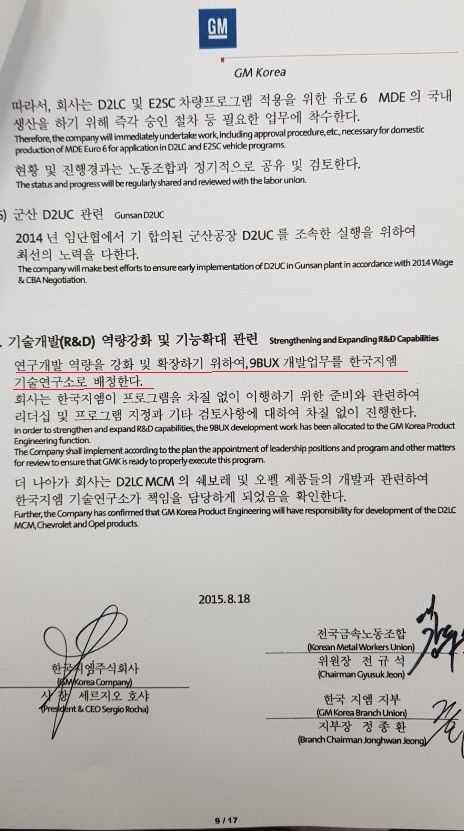Posted on : Mar.12,2019 17:33 KST
 |
|
A copy of an agreement reached between GM Korea and labor unions in August 2015 regarding the development of GM’s next-generation compact SUV Trax. (provided by GM Korea)
|
Management and labor continue dispute over classification of “compact”
 |
|
A copy of an agreement reached between GM Korea and labor unions in August 2015 regarding the development of GM’s next-generation compact SUV Trax. (provided by GM Korea)
|
What kind of car is GM’s next-generation compact SUV Trax (development code name 9BUX)? The recent controversy surrounding GM Korea centers on that question.
GM Global, the majority shareholder of GM Korea, and Korea Development Bank (KDB), its second-largest shareholder, held three months of negotiations last year on whether to split off a separate GM Korea research and development entity. The final agreement announced on Dec. 18 involved allowing the spinoff to go ahead, with the new corporate entity to be assigned under GM Global and designated as a “focused compact SUV and CUV R&D base.”
On Mar. 8, it emerged that the compact SUV in question was the 9BUX. It also came to light that the original wording of the agreement referred specific to GM Korea as a “homeroom of C[-segment] SUV and CUV based on 9b platform.”
The biggest point of contention is the fact that South Korean development of the 9BUX was already decided upon four years ago. According to the Hankyoreh’s examination of a 2015 agreement resulting from GM Korea wage negotiations and collective bargaining, labor and management agreed at the time that 9BUX development duties would be “allocated to the GM Korea Product Engineering function” in order to “strengthen and expand R&D capabilities.” Development of the next-generation Trax (9BUX) subsequently proceeded under South korean leadership, with mass-production scheduled to begin at the Bupyeong factory in 2020. According to press reports, a vehicle believed to be the 9BUX was seen recently being test-driven in Incheon. Development of the vehicle appears to be more or less complete.
GM Korea Chairman Kaher Kazem has also never modified the official position in his July 2018 announcement of plans for the new R&D entity, in which he stated that South Korean engineers would be developing a next-generation compact SUV product. The first official explanation came on Mar. 7 when Jeon Ju-myeong, vice president of GM Technical Center Korea (the new R&D entity affiliated with GM Global), told the union that compacts would be “produced by China.”
Further fueling the controversy was GM Korea’s explanation that the next-generation Trax would be “small” rather than “compact.” A request for designation of a “foreign investment zone” submitted by GM to the city of Incheon on Mar. 13 of last year stated that the company would need 948.2 billion won (US$839.65 million) over five years to “build and expand a manufacturing process for small SUVs in the Bupyeong area.” After previously being categorized as “small,” the vehicle was changed to “compact” toward the end of the year. According to GM’s segment classification, the B-segment refers to small vehicles and the C-segment to subcompact and compact vehicles.
Because of this, the union and industry anticipated that the “compact SUV” agreed upon late last year by GM and KDB would be a new model.
“We never imagined it would be the 9BUX,” said one union official.
“The technology volume that the union achieved through difficult negotiations with the company four years ago is now being boasted about by KDB as if it were a new result of negotiations, and GM is making out as though it’s giving something new,” the official added.
“After 800 billion won (US$708.56 million) in taxpayer money was sunk into it, the result is basically the status quo.”
GM Korea disputed the claim that the negotiations had preserved the status quo.
“The big issue in our negotiations with KDB last year was whether there could be CUV development in South Korea,” said a GM Korea official.
“The CUV ended up being developed in South Korea rather than a compact, and it’s a base for corresponding model development. That’s quite an achievement,” the official added.
A government official familiar with the negotiation process said, “My understanding is that the change in the 9BUX’s segment was meant to underscore the distinction of the new vehicle, which has a bigger chassis than the previous Trax.”
By Choi Ha-yan, staff reporter
Please direct comments or questions to [english@hani.co.kr]










